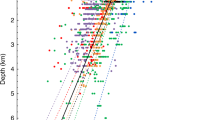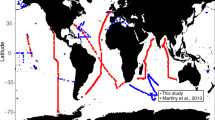Abstract
The Southern Ocean, and in particular the Weddell Sea, have long been considered areas of high biological productivity1, but recent isotopic measurements of primary productivity have not confirmed this view2,3. Because the large Zooplankton and marine mammal populations of the Southern Ocean depend ultimately on phytoplankton as the base of the food web, accurate knowledge of primary productivity is essential to our understanding of the Antarctic ecosystem. Oceanographie data collected aboard the Soviet icebreaker Mikhail Somov have allowed us to derive a new productivity estimate, based on the seasonal depletion of nitrate, phosphate and silicic acid in the surface layer. From these depletions and data on the elemental composition of Southern Ocean phytoplankton, we estimate average primary productivity in the Weddell Sea in the springtime to be 220–420 mg C m−2 day−1. Our most conservative estimate is 1.5–4 times higher than recently reported measurements of productivity in the open ocean areas of the Southern Ocean2–5. Our estimates are inherently averages over time and space, including the effects of brief, intense spring blooms of phytoplankton which may occur near the receding ice edge6–8. Studies of primary productivity based on isotope uptake experiments, particularly in the austral summer, may fail to account for the significance of such blooms.
This is a preview of subscription content, access via your institution
Access options
Subscribe to this journal
Receive 51 print issues and online access
$199.00 per year
only $3.90 per issue
Buy this article
- Purchase on Springer Link
- Instant access to full article PDF
Prices may be subject to local taxes which are calculated during checkout
Similar content being viewed by others
References
Hart, T. J. Discovery Rep. 8, 3–268 (1934).
Holm-Hansen, O., El-Sayed, S. Z., Franceschini, G. A. & Cuchel, R. L. in Proc. 3rd SCAR Symp. Antarctic Biology, 11–50 (Smithsonian Institution, Washington DC, 1977).
El-Sayed, S. Z. & Turner, J. T. in Polar Oceans (ed. Dunbar, M. J.) 463–503 (Arctic Institute of North America, Calgary, Alberta, 1977).
Gilbert, P. M., Biggs, D. C. & McCarthy, J. J. Deep-Sea Res. 29, 837–850 (1982).
Slawyk, G. Aust. J. mar. Freshwat. Res. 30, 431–448 (1977).
El-Sayed, S. Z. in Biology of the Antarctic Seas Vol. 4 (eds Land, G. & Wallen, I.) 301–312 (American Geophysical Union, Washington DC, 1971).
Olson, R. J. Limnol. Oceanogr. 25, 1064–1074 (1980).
Smith, W. O. & Nelson, D. M. in Proc. 4th Symp. Antarctic Biology (Elsevier, New York, in the press).
Gordon, A. L. & Huber, B. A. J. geophys. Res. 89 (C1), 641–648 (1984).
Gordon, A. L., Chen, C. T. A. & Metcalf, W. G. J. geophys. Res. 89 (C1), 637–640 (1984).
Clarke, D. B. & Askley, S. F. J. geophys. Res. (in the press).
Jennings, J. C. Jr, Nelson, D. M. & Gordon, L. I. Antarct. J. U.S. 8, 101 (1982).
Carmack, E. C. & Foster, T. D. Deep-Sea Res. 22, 711–724 (1975).
Bainbridge, A. E., Geosecs Atlantic Expedition Vol. 1 (National Science Foundation, Washington DC, 1981).
Huber, B. A., Rennie, S. E., Georgi, D. T., Jacobs, S. S. & Gordon, A. L. Islas Orcadas Reports, Cruise 12, Jan–Feb 1977, Tech. Rep. CU-2-81-TR2 (Larnont-Doherty Geological Observatory, Columbia University, Palisades, 1981).
Mosby, H. Scientific Results of the Norwegian Antarctic Expeditions, 1927–1928, Vol. 1(11) (Det Norske Videnskaps-Academi I, Oslo, 1934).
Gordon, A. L., Martinson, D. G. & Taylor, H. W. Deep-Sea Res. 28 A, 151–163 (1981).
Gordon, A. L. J. geophys. Res. 86, 493–4197 (1981).
Ackley, S. F. Int. Ass. hydrol. Sci. 131, 129–159 (1981).
Marra, J. & Boardman, D. C. Mar. Ecol.-Prog. Ser. (submitted).
Nelson, D. M. & Gordon, L. I. Geochim. cosmochim. Acta 46, 491–501 (1982).
Redfield, A. C., Ketchum, B. H. & Richards, F. A. in The Sea, Ideas and Observations Vol. 2, 26–77 (Interscience, New York, 1963).
Copin-Montegut, C. & Copin-Montegut, G. Deep-Sea Res. 25, 911–931 (1978).
El-Sayed, S. Z. & Taguchi, S. Deep-Sea Res. 28 A, 1017–1032 (1981).
Author information
Authors and Affiliations
Rights and permissions
About this article
Cite this article
Jennings, J., Gordon, L. & Nelson, D. Nutrient depletion indicates high primary productivity in the Weddell Sea. Nature 309, 51–54 (1984). https://doi.org/10.1038/309051a0
Received:
Accepted:
Issue Date:
DOI: https://doi.org/10.1038/309051a0
This article is cited by
-
Characteristics of particle fluxes in the Prydz Bay polynya, Eastern Antarctica
Science China Earth Sciences (2019)
-
Large seasonal variation in phytoplankton production in the Amundsen Sea
Polar Biology (2015)
-
Phytoplankton production after the collapse of the Larsen A Ice Shelf, Antarctica
Polar Biology (2009)
-
Whole season net community production in the Weddell Sea
Polar Biology (2007)
-
Spatial and Temporal Variation of Surface xCO2 Providing Net Biological Productivities in the Western North Pacific in June
Journal of Oceanography (2005)
Comments
By submitting a comment you agree to abide by our Terms and Community Guidelines. If you find something abusive or that does not comply with our terms or guidelines please flag it as inappropriate.



